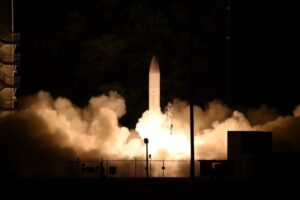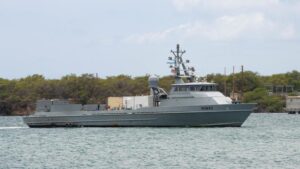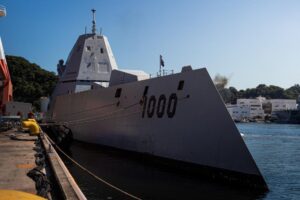The Navy is not currently considering adding hypersonic missiles to Large Unmanned Surface Vehicles (LUSV), but the service may consider that after initial testing from the USS Zumwalt (DDG-1000) in 2025, a senior Navy surface warfare said Friday.
When asked if LUSV is a possible opportunity to accelerate the Conventional Prompt Strike (CPS) system the Navy is adding to two platforms this decade, Rear Adm. Fred Pyle, director, of the Surface Warfare Division, N96, in the Office of the Chief of Naval Operations, said “that’s absolutely something we could look at.”

While Pyle emphasized he was not making news and the Navy is sequencing the CPS system and still in the early design phase of LUSV, he said he expects many Navy leaders will want to spread the capability among more platforms once initial flight tests occur.
“I anticipate whenever we have that successful demonstration, there will be an insatiable appetite by folks like me, a lot of senior Navy leaders, on how we proliferate this capability across the fleet. So that’s absolutely something we should consider,” Pyle said.
The Navy plans to replace the unused gun system on DDG-1000 with four 87-inch large missile vertical launch system (LMVLS) tubes to host up to 12 CPS hypersonic missiles during an 18-month drydock availability due to start later this year and run into 2025. The service has directed the first two to three CPS test shots off the destroyer should occur by December 2025.

“The focus of this install on the Zumwalt-class, is to get CPS, Conventional Prompt Strike, and demonstrate that by ‘25, period. That’s pretty good guidance…direction from SECNAV and CNO. So we’re really laser focused on that,” Pyle said.
In November, Vice Adm. Johnny Wolfe, the Navy’s director for Strategic Systems Programs, said the primary challenge of this integration is finishing the work in time (Defense Daily, Nov. 8).
The Navy plans to ultimately install CPS on all three Zumwalt-class destroyers and equip the hypersonic missiles onto the first Virginia-class submarine equipped with the Virginia Payload Module by 2029.
The Army is set to first deploy an initial unit equipped with the truck-launched version of the weapon this year.
General Dynamics’ Bath Iron Works (BIW) [GD] built the three Zumwalt-class destroyers, but HII made the deckhouses.
In January, the Navy awarded HII a $10.5 million contract to plan the modernization work for installing the CPS (Defense Daily, Jan. 9).

The Navy has said it plans to upgrade the USS Michael Monsoor (DDG-1001) to the same effect from FY ‘26 to FY ‘28.
Relatedly, Pyle also said while this initial upgrade is focused on adding the hypersonic missile capability he wants to ultimately upgrade further and add other systems like the Raytheon Technologies [RTX] SPY-6 radar, Standard Missile-6, Standard Missile-3 and the Lockheed Martin [LMT] Aegis Combat System Baseline 10.
“Where we want to get to is where that platform is interoperable with the rest of the fleet. Not there yet. It’s something we’re working on, the short answer…is yes, we want to get there. But there’s still work to do,” he said.
He added that as the surface warfare director, “I want to get to…make sure that that ship has Aegis-like capability, is completely interoperable, and when it goes west, it’s plug and play.”